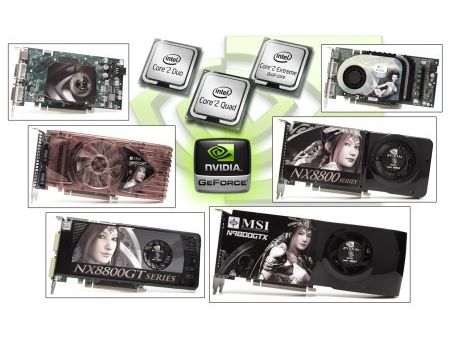GPU vs. CPU Upgrade: Extensive Tests
Test Subjects: Four Generations of Nvidia Chips
Editor’s Note: Prices in this article are presented mostly in Euros. The purpose of this article is to show relative pricing and relative price/performance ratios, not highly accurate current pricing. Therefore, we feel that Euro based pricing is acceptable here.
This is an endless topic of conversation, with everybody you meet having their own pet opinion. What brings better results, purchasing a faster graphics card, or investing your cash in a more powerful processor? In an effort to find out, Tom’s Hardware has taken a good look at the most important chips. In this article, the Geforce 6800 GT, 7950 GT, 8800 GT, 8800 GTS 512, 9600 GT 1024 and 9800 GTX are up for cross-testing in terms of performance comparisons, and pitted against current CPUs like the E2160, E6750, Q6600 and X6800EE.
The results should clarify how much performance is obtained by upgrading the various components, as well as which combinations work best or are cheapest. It will also show us how high the basic performance level of the processor needs to be in order for the new G92 graphics chips from Nvidia to develop their full 3D speed potential. The comprehensive tables and performance analyses show clear results detailing the effects of a CPU upgrade on Geforce 6 and 7, and whether it might just be better to go for the new graphics card generation with DirectX 10.
The test platform used is based on an X38 chipset with DDR3 memory and PCI Express 2.0 interface, and remains identical for all of the individual tests. Generally speaking, only the graphics and CPU performance is changed for each run. In order to ensure that the E2160 and Q6600 are able to keep up with the other processors, two additional test runs have been performed in which the Front Side Bus (FSB) was overclocked by 33-34%. The test results indicate whether simply overclocking the small cache budget CPU is able to compensate for its initial performance deficit, and how much performance the quad core is able to pull from its reserves as a result of the increased frequencies.
Get Tom's Hardware's best news and in-depth reviews, straight to your inbox.
Current page: Test Subjects: Four Generations of Nvidia Chips
Next Page Comparison of Graphics Chips and Introduction of the Test Configuration-
randomizer That would simply consume more time without really proving much. I think sticking with a single manufacturer is fine, because you see the generation differences of cards and the performance gains compared to geting a new processor. You will see the same thing with ATI cards. Pop in an X800 and watch it crumble in the wake of a HD3870. There is no need to inlude ATI cards for the sake of this article.Reply -
randomizer This has been a long needed article IMO. Now we can post links instead of coming up with simple explanations :DReply -
yadge I didn't realize the new gpus were actually that powerful. According to Toms charts, there is no gpu that can give me double the performance over my x1950 pro. But here, the 9600gt was getting 3 times the frames as the 7950gt(which is better than mine) on Call of Duty 4.Reply
Maybe there's something wrong with the charts. I don't know. But this makes me even more excited for when I upgrade in the near future. -
This article is biased from the beginning by using a reference graphics card from 2004 (6800GT) to a reference CPU from 2007 (E2140).Reply
Go back and use a Pentium 4 Prescott (2004) and then the basis of these percentage values on page 3 will actually mean something. -
randomizer yadgeI didn't realize the new gpus were actually that powerful. According to Toms charts, there is no gpu that can give me double the performance over my x1950 pro. But here, the 9600gt was getting 3 times the frames as the 7950gt(which is better than mine) on Call of Duty 4. Maybe there's something wrong with the charts. I don't know. But this makes me even more excited for when I upgrade in the near future.I upgraded my X1950 pro to a 9600GT. It was a fantastic upgrade.Reply -
wh3resmycar scyThis article is biased from the beginning by using a reference graphics card from 2004 (6800GT) to a reference CPU from 2007 (E2140).Reply
maybe it is. but its relevant especially with those people who are stuck with those prescotts/6800gt. this article reveals an upgrade path nonetheless -
randomizer If they had used P4s there would be o many variables in this article that there would be no direction and that would make it pointless.Reply -
JAYDEEJOHN Great article!!! It clears up many things. It finally shows proof that the best upgrade a gamer can make is a newer card. About the P4's, just take the clock rate and cut it in half, then compare (ok add 10%) hehehReply -
justjc I know randomizer thinks we would get the same results, but would it be possible to see just a small article showing if the same result is true for AMD processors and ATi graphics.Reply
Firstly we know that ATi and nVidia graphics doesn't calculate graphics in the same way, who knows perhaps an ATi card requiers more or less processorpower to work at full load, and if you look at Can you run it? for Crysis(only one I recall using) you will see the minimum needed AMD processor is slover than the minimum needed Core2, even in processor speed.
So any chance of a small, or full scale, article throwing some ATi and AMD power into the mix?
